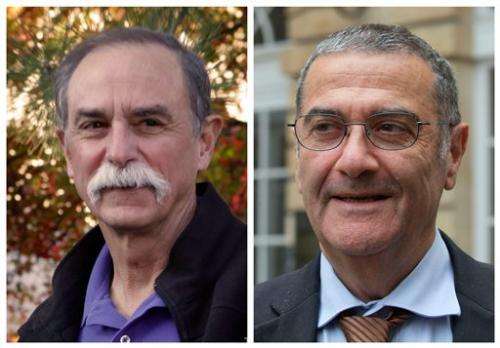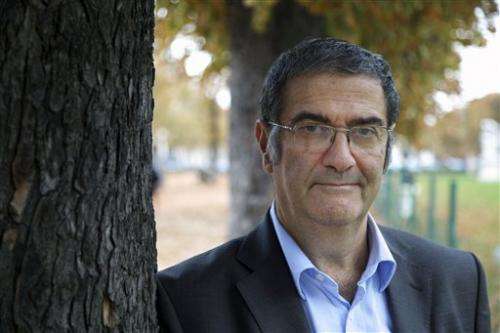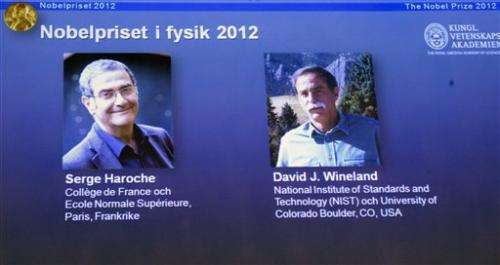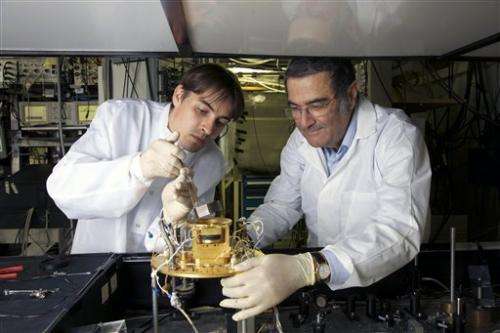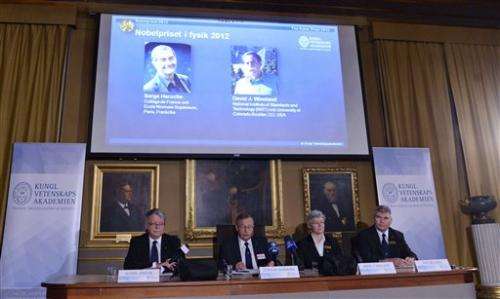In this combination of photos made Tuesday, Oct. 9, 2012, American physicist David Wineland, left, poses at his home in Boulder, Colo., and French physicist Serge Haroche speaks to the media in Paris after they were named winners of the 2012 Nobel Prize in physics. The French-American duo shared the prize for experiments on quantum particles that have already resulted in ultra-precise clocks and may one day help lead to computers many times faster than those in use today. (AP Photo/Ed Andrieski, left; Michel Euler, right)
A Frenchman and an American shared the Nobel Prize in physics Tuesday for inventing methods to peer into the bizarre quantum world of ultra-tiny particles, work that could help in creating a new generation of super-fast computers.
Serge Haroche of France and American David Wineland opened the door to new experiments in quantum physics in the 1990s by showing how to observe individual atoms and particles of light called photons while preserving their quantum properties.
Quantum physics, a field about a century old, explains a lot about nature but includes some weird-sounding behavior by individual, isolated particles. A particle resists our idea of either-or: it's not here or there, it's sort of both. It's not spinning clockwise or counter-clockwise, but a bit of both. It gets a definite location or spin only when it's measured.
Working separately, the two scientists, both 68, developed "ingenious laboratory methods" that allowed them to manage and measure and control fragile quantum states, the Royal Swedish Academy of Sciences said.
Wineland traps ions—electrically charged atoms—and measures them with light, while Haroche controls and measures photons.
This 2009 photo provided Tuesday Oct. 9, 2012 by the CNRS (Centre Nationale de la Recherche Scientifique) shows French physician Serge Haroche in Paris. Haroche and U.S David Wineland share the 2012 Nobel Prize in physics Tuesday Oct. 9, 2012 for inventing methods to observe the bizarre properties of the quantum world, research that has led to the construction of extremely precise clocks and helped scientists take the first steps toward building superfast computers. (AP Photo/CNRS/ Christophe Lebedinsky)
"Their ground-breaking methods have enabled this field of research to take the very first steps towards building a new type of superfast computer based on quantum physics," the academy said. "The research has also led to the construction of extremely precise clocks that could become the future basis for a new standard of time."
Haroche is a professor at the College de France and Ecole Normale Superieure in Paris. Wineland is a physicist at the National Institute of Standards and Technology, or NIST, and the University of Colorado in Boulder.
Haroche said he was out walking with his wife in Paris when he got the call from the Nobel judges.
"I was in the street and passing a bench so I was able to sit down," Haroche told a news conference in Stockholm by telephone. "It's very overwhelming."
He said his work in the realm of quantum physics could ultimately lead to unimaginably fast computers. "You can do things which are prohibited by the laws of classical physics," he told The Associated Press.
Photographs of the 2012 Nobel Prize laureates in Physics Serge Haroche from France, left, and David Wineland from the US are presented on a screen during a media conference at the Royal Swedish Academy of Science in Stockholm, Sweden, Tuesday Oct. 9, 2012. Frenchman Serge Haroche and American David Wineland have won the 2012 Nobel Prize in physics for inventing and developing methods for observing tiny quantum particles without destroying them. (AP Photo/Bertil Enevag Ericson/SCANPIX)
Haroche also said quantum research could help make GPS navigating systems more accurate.
Wineland told the AP he was sleeping when his wife answered the phone at 3:30 a.m. local time in Denver. He was utterly shocked even though his name had come up before.
"But actually I hadn't heard anything this time around. It was certainly surprising and kind of overwhelming right now," he said. "I feel like I got a lot smarter overnight."
Asked how he will celebrate, Wineland said: "I'll probably be pretty worn out by this evening. I'll probably have a glass of wine and fall asleep."
This 2009 photo provided Tuesday Oct. 9, 2012 by the CNRS (Centre Nationale de la Recherche Scientifique) shows French physician Serge Haroche, right, and his aide Igor Dotsenko in Paris. Haroche and U.S David wineland share the 2012 Nobel Prize in physics Tuesday Oct. 9, 2012 for inventing methods to observe the bizarre properties of the quantum world, research that has led to the construction of extremely precise clocks and helped scientists take the first steps toward building superfast computers. (AP Photo/CNRS/ Christophe Lebedinsky)
Wineland took pains to note that many people are working in the field. "First of all, a lot of people have been working on advanced computers and atomic clocks for a long time. It's a bit embarrassing to focus on just two individuals," he said.
Wineland told reporters that he thinks that in the next decade or so, quantum computers will cross a threshold and be able to handle problems that are intractable on today's computers.
"At this point I wouldn't recommend anybody buy stock in a quantum computing company ... but we're optimistic," he said.
The Nobel judges said quantum computers could radically change people's lives in the way that classical computers did last century, but a full-scale quantum computer is still decades away.
"The calculations would be incredibly much faster and exact and you would be able to use it for areas like ... measuring the climate of the earth," said Lars Bergstrom, the secretary of the prize committee.
Christopher Monroe, who does similar work at the Joint Quantum Institute at the University of Maryland, said the awarding of the prize to the two men "is not a big surprise to me. ... It was sort of obvious that they were a package."
Photographs of the 2012 Nobel Prize laureates in Physics Serge Haroche from France, left, and David Wineland from the US are presented on a screen during a media conference at the Royal Swedish Academy of Science in Stockholm, Sweden, Tuesday Oct. 9, 2012. Frenchman Serge Haroche and American David Wineland have won the 2012 Nobel Prize in physics for inventing and developing methods for observing tiny quantum particles without destroying them. The Royal Swedish Academy of Sciences cited the two scientists Tuesday "for ground-breaking experimental methods that enable measuring and manipulation of individual quantum systems." (AP Photo / Bertil Enevag Ericson / SCANPIX)
Monroe said that thanks to the bizarre properties of the quantum world, when he and Wineland worked together in the 1990s, they were able to put a single atom in two places simultaneously.
At that time, it wasn't clear that trapping single atoms could help pave the way to superfast quantum computers, he said. That whole field "just fell into our laps."
In an ordinary computer, information is represented in bits, each of which is either a zero or a one. But in a quantum computer, an individual particle can essentially represent a zero and a one at the same time. If scientists can make such particles work together, certain kinds of calculations could be done with blazing speed.
One example is factoring, the process of discovering what numbers can be multiplied together to produce a given number. That has implications for breaking codes, Monroe said.
The physics prize was the second of the 2012 Nobel Prizes to be announced, with the medicine award going Monday to stem cell pioneers John Gurdon of Britain and Japan's Shinya Yamanaka. Each award is worth 8 million kronor, or about $1.2 million.
Only two women have won the physics prize since it was first awarded in 1901: Marie Curie in 1903 and Maria Goeppert-Mayer in 1963.
The prizes are always handed out on Dec. 10, the anniversary of prize founder Alfred Nobel's death in 1896.
Recent winners of the Nobel Prize in physics
Recent winners of the Nobel Prize in physics, and their research, according to the Nobel Foundation:
— 2012: Serge Haroche of France and David Wineland of the U.S. for "for ground-breaking experimental methods" that enable measuring and manipulation of individual quantum systems
— 2011: American physicist Saul Perlmutter, U.S.-Australian researcher Brian Schmidt and American professor Adam Riess "for the discovery of the accelerating expansion of the Universe through observations of distant supernovae."
— 2010: Russian-born scientists Andre Geim and Konstantin Novoselov for "ground-breaking experiments regarding the two-dimensional material graphene."
— 2009: British-American Charles K. Kao, Canadian-American Willard S. Boyle and American George E. Smith for breakthroughs in fiber optics and the invention of an imaging semiconductor circuit.
— 2008: U.S. citizen Yoichiro Nambu and Japanese researchers Makoto Kobayashi and Toshihide Maskawa for work on "spontaneous broken symmetry" in subatomic physics.
— 2007: France's Albert Fert and Germany's Peter Gruenberg for work on the discovery of giant magnetoresistance.
— 2006: Americans John C. Mather and George F. Smoot for work examining the infancy of the universe, aiding the understanding of galaxies and stars and increasing support for the Big Bang theory of the beginning of the universe.
— 2005: Americans John L. Hall and Roy J. Glauber and German Theodor W. Haensch, for research explaining the behavior of light particles and determining the frequency of light with great precision.
— 2004: Americans David J. Gross, H. David Politzer and Frank Wilczeck, for their work in the discovery and exploration of strong force and quarks.
— 2003: Alexei A. Abrikosov, United States and Russia, Anthony J. Leggett, United States and Britain, and Vitaly L. Ginzburg, Russia, for their work concerning superconductivity and superfluidity in the field of quantum physics.
— 2002: Raymond Davis, Jr., United States, and Masatoshi Koshiba, Japan, for their research into cosmic neutrinos; and Riccardo Giacconi, United States, for pioneering contributions to astrophysics that led to the discovery of cosmic X-ray sources.
— 2001: Eric A. Cornell and Carl E. Wieman, United States, and U.S.-based researcher Wolfgang Ketterle of Germany for creating a new state of matter, an ultra-cold gas known as Bose-Einstein condensate.
— 2000: Zhores I. Alferov, Russia, U.S.-based researcher Herbert Kroemer of Germany, and Jack Kilby, United States, for work that helped create modern information technology.
— 1999: Gerardus 't Hooft and Martinus J.G. Veltman, Netherlands, for their theoretical work on the structure and motion of subatomic particles.
— 1998: Robert B. Laughlin, United States, Horst L. Stoermer, Germany, and Daniel C. Tsui, United States, for discovering a new form of quantum fluid that gives more profound insights into the general inner structure and dynamics of matter.
— 1997: Steven Chu and William D. Phillips, United States, and Claude Cohen-Tannoudji, France, for their work in cooling and trapping atoms with laser light.
A glance at the Nobel Prize for physics
WHO WON?
Frenchman Serge Haroche of the College de France and Ecole Normale Superieure, Paris, and American David Wineland of the University of Colorado in Boulder.
FOR WHAT?
The two were cited for inventing and developing methods for observing tiny quantum particles without destroying them.
THE SIGNIFICANCE?
Their research has led to the construction of extremely precise clocks that could become the basis for a new standard of measuring time and helped scientists take the first steps toward building superfast computers.
WHAT THEY SAID?
Haroche: "It's very overwhelming. ... At first I called my children. ... There are a lot of people in the world that deserve the prize so I tried to not to expect too much." Wineland: "It was certainly surprising, and kind of overwhelming right now...I feel like I got a lot smarter overnight. ... When they also told me that the prize was shared with a good friend, that was nice to hear, too."
More information: www.nobelprize.org/nobel_prize … ics/laureates/2012/#
Nobel Committee announcement:
Particle control in a quantum world
Serge Haroche and David J. Wineland have independently invented and developed methods for measuring and manipulating individual particles while preserving their quantum-mechanical nature, in ways that were previously thought unattainable.
The Nobel Laureates have opened the door to a new era of experimentation with quantum physics by demonstrating the direct observation of individual quantum particles without destroying them. For single particles of light or matter the laws of classical physics cease to apply and quantum physics takes over. But single particles are not easily isolated from their surrounding environment and they lose their mysterious quantum properties as soon as they interact with the outside world. Thus many seemingly bizarre phenomena predicted by quantum physics could not be directly observed, and researchers could only carry out thought experiments that might in principle manifest these bizarre phenomena.
Through their ingenious laboratory methods Haroche and Wineland together with their research groups have managed to measure and control very fragile quantum states, which were previously thought inaccessible for direct observation. The new methods allow them to examine, control and count the particles.
Their methods have many things in common. David Wineland traps electrically charged atoms, or ions, controlling and measuring them with light, or photons.
Serge Haroche takes the opposite approach: he controls and measures trapped photons, or particles of light, by sending atoms through a trap.
Both Laureates work in the field of quantum optics studying the fundamental interaction between light and matter, a field which has seen considerable progress since the mid-1980s. Their ground-breaking methods have enabled this field of research to take the very first steps towards building a new type of super fast computer based on quantum physics. Perhaps the quantum computer will change our everyday lives in this century in the same radical way as the classical computer did in the last century. The research has also led to the construction of extremely precise clocks that could become the future basis for a new standard of time, with more than hundred-fold greater precision than present-day caesium clocks.
Copyright 2012 The Associated Press. All rights reserved. This material may not be published, broadcast, rewritten or redistributed.
